-

新人教版高中英语选修2Unit 4 Using langauge-Listening教学设计
The theme of the listening section is " talking about scenery and culture along a journey."The part is designed to further lead the students to understand Canadian natural geography and social environment, and integrated into the cultural contrast by mentioning the long train journey from Beijing to Moscow routes. On this basis, the part activates students related travel experience, lets the student serial dialogue, guides the student to explore further the pleasure and meaning of the long journey, and Chinese and foreign cultural comparison.The part also provides a framework for the continuation of the dialogue, which is designed to provide a framework for students to successfully complete their oral expressions, and to incorporate an important trading strategy to end the dialogue naturally.1. Help students to understand and master some common English idioms in the context, and experience the expression effect of English idioms.2. Guide the students to understand the identity of different people in the listening context, and finish the dialogue according to their own experience.3. Instruct the students to use appropriate language to express surprise and curiosity about space and place in the dialogue, and master the oral strategy of ending the dialogue naturally.1. Instruct students to grasp the key information and important details of the dialogue.2. Instruct students to conduct a similar talk on the relevant topic.

新人教版高中英语选修2Unit 5 Learning about Language教学设计
The purpose of this section of vocabulary exercises is to consolidate the key words in the first part of the reading text, let the students write the words according to the English definition, and focus on the detection of the meaning and spelling of the new words. The teaching design includes use English definition to explain words, which is conducive to improving students' interest in vocabulary learning, cultivating their sense of English language and thinking in English, and making students willing to use this method to better grasp the meaning of words, expand their vocabulary, and improve their ability of vocabulary application. Besides, the design offers more context including sentences and short passage for students to practice words flexibly.1. Guide students to understand and consolidate the meaning and usage of the vocabulary in the context, 2. Guide the students to use the unit topic vocabulary in a richer context3. Let the students sort out and accumulate the accumulated vocabulary, establishes the semantic connection between the vocabulary,4. Enable students to understand and master the vocabulary more effectivelyGuiding the Ss to use unit topic words and the sentence patterns in a richer context.Step1: Read the passage about chemical burns and fill in the blanks with the correct forms of the words in the box.

新人教版高中英语选修2Unit 5 Reading and thinking教学设计
The theme of this activity is to learn the first aid knowledge of burns. Burns is common in life, but there are some misunderstandings in manual treatment. This activity provides students with correct first aid methods, so as not to take them for granted in an emergency. This section guides students to analyze the causes of scald and help students avoid such things. From the perspective of text structure and collaborative features, the text is expository. Expository, with explanation as the main way of expression, transmits knowledge and information to readers by analyzing concepts and elaborating examples. This text arranges the information in logical order, clearly presents three parts of the content through the subtitle, accurately describes the causes, types, characteristics and first aid measures of burns, and some paragraphs use topic sentences to summarize the main idea, and the level is very clear.1. Guide students to understand the causes, types, characteristics and first aid methods of burns, through reading2. Enhance students’ ability to deal withburnss and their awareness of burns prevention3. Enable students to improve the ability to judge the types of texts accurately and to master the characteristics and writing techniques of expository texts.Guide students to understand the causes, types, characteristics and first aid methods of burns, through readingStep1: Lead in by discussing the related topic:1. What first-aid techniques do you know of ?CPR; mouth to mouth artificial respiration; the Heimlich Manoeuvre

新人教版高中英语选修2Unit 5 Using langauge-Listening教学设计
The theme of this section is to learn how to make emergency calls. Students should learn how to make emergency calls not only in China, but also in foreign countries in English, so that they can be prepared for future situations outside the home.The emergency telephone number is a vital hotline, which should be the most clear, rapid and effective communication with the acute operator.This section helps students to understand the emergency calls in some countries and the precautions for making emergency calls. Through the study of this section, students can accumulate common expressions and sentence patterns in this context. 1.Help students accumulate emergency telephone numbers in different countries and learn more about first aid2.Guide the students to understand the contents and instructions of the telephone, grasp the characteristics of the emergency telephone and the requirements of the emergency telephone.3.Guide students to understand the first aid instructions of the operators.4.Enable Ss to make simulated emergency calls with their partners in the language they have learned1. Instruct students to grasp the key information and important details of the dialogue.2. Instruct students to conduct a similar talk on the relevant topic.Step1:Look and discuss:Match the pictures below to the medical emergencies, and then discuss the questions in groups.
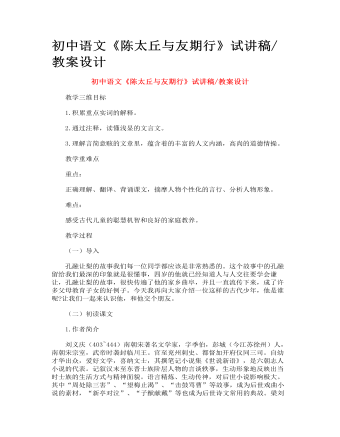
初中语文《陈太丘与友期行》试讲稿_教案设计
刘义庆(403~444)南朝宋著名文学家,字季伯,彭城(今江苏徐州)人,南朝宋宗室,武帝时袭封临川王。官至兖州刺史、都督加开府仪同三司。自幼才华出众,爱好文学,喜纳文士,其撰笔记小说集《世说新语》,是六朝志人小说的代表。记叙汉末至东晋士族阶层人物的言谈轶事,生动形象地反映出当时士族的生活方式与精神面貌。语言精炼、生动传神,对后世小说影响极大。其中“周处除三害”、“望梅止渴”、“击鼓骂曹”等故事,成为后世戏曲小说的素材,“新亭对泣”、“子猷献戴”等也成为后世诗文常用的典故。梁刘孝标作注,旁征博引,为后人所重。另有《幽明录》,今佚。鲁迅《古小说钩沉》辑其佚文200余条,皆记诡异之事。
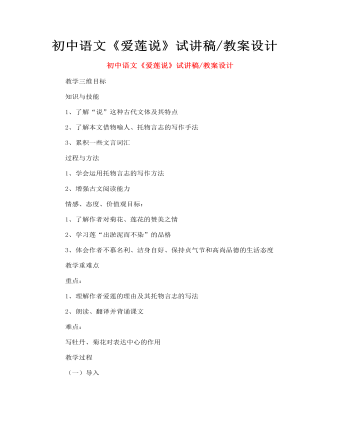
初中语文《爱莲说》试讲稿_教案设计
初读课文 了解文体,熟悉作者 文章的题目是《爱莲说》“爱”表现了作者的感情,“莲”是这篇文章写作的主体,“说” 在这里指什么? 明确:“说”是一种文体,可以说明事物,也可以发表议论或记叙事物 “说”这种文体可以灵活地运用说明、记叙和议论的表达方式,偏重于议论那么题目的意思是什么呢?可以理解为“谈谈爱莲花的道理”或“说说喜爱莲花的道理” 他爱莲花有什么道理呢?大家在学习课文中一定要开动小脑筋 本文作者周敦颐 ,(10171073) ,宋代道洲(现在湖南省道县)人,字茂叔,哲学家因他世居道县濂溪,后居庐山莲花峰前,峰下有溪,也命名为濂溪,学者就称他为“濂溪先生”
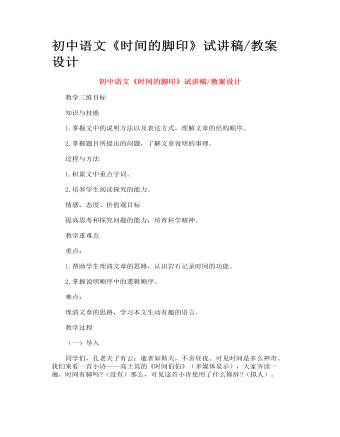
初中语文《时间的脚印》试讲稿_教案设计
同学们,孔老夫子有云:逝者如斯夫,不舍昼夜。可见时间是多么神奇。我们来看一首小诗——高士其的《时间伯伯》(多媒体显示),大家齐读一遍。时间有脚吗?(没有)那么,可见这首小诗使用了什么修辞?(拟人)。 我们今天学习的课文文题就源于高士其这首小诗。(板书课题:8.时间的脚印)这课题也采用什么修辞?(拟人)这是一篇科普作品,了解一下它的作者( 看图了解陶世龙)。先来欣赏图片,第一张自然界中的沉积岩、第二张“恐龙化石”、第三张“三叶虫化石”。(屏幕显示)。我们看到的这些岩石,在保存古代生物的同时,还记下了时间的痕迹。那么,岩石是怎样记录时间的呢?带着这个问题,我们一起来学习《时间的脚印》。我们来看看这节课的学习目标。
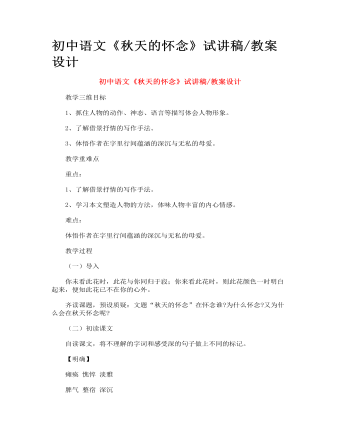
初中语文《秋天的怀念》试讲稿_教案设计
深层探究 在那个树叶“刷刷拉拉”飘落的季节里,母亲离我远去了。我怀念我的母亲,怀念她为我付出的艰辛,为我承受的苦痛和她给予我的爱。除此,母亲还给了我更为宝贵的东西,那是什么? 【明确】:是母亲交给我的生活态度,价值观,她让我有了直面苦难的勇气、信心和力量。 这世间有很多东西,当我们懂得珍惜,回头却发现他已经不在了。比如说光阴、健康、生命、亲情、友情…… 史铁生和母亲的故事,史铁生“好好活”的人生一定让你有所触动,有些问题你可能没有想过,有些话你也没有说过,因为你还拥有着。 (让学生充分展示,说出自己的心里话。) 小结:这是一位病入膏肓的母亲,一位苦难坚忍的母亲;这是一位强大智慧的母亲,一位大爱无声的母亲!这个母亲养育了我,陪伴了我,成就了我。 天底下每一位母亲都同样伟大。她们为儿女同样倾我所有,操尽心机;她们同样青丝白发,毫无保留。
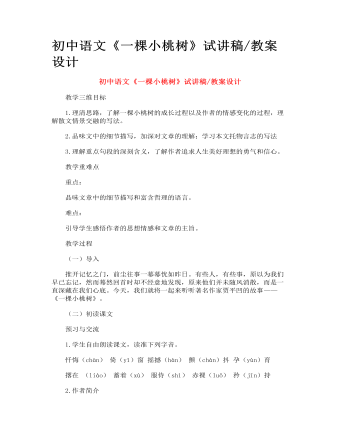
初中语文《一棵小桃树》试讲稿_教案设计
贾平凹,1952年2月21日生于陕西省商洛市丹凤县棣花镇,当代作家。 1974年开始发表作品。1975年毕业于西北大学中文系。1978年凭借《满月儿》,获得首届全国优秀短篇小说奖。1982年发表作品《鬼城》《二月杏》。1992年创刊《美文》。1993年创作《废都》。20**年,先后担任西安建筑科技大学人文学院院长、文学院院长。20**年凭借《秦腔》,获得第七届茅盾文学奖。20**年凭借《古炉》 ,获得施耐庵文学奖。20**年3月22日,澳门大学向贾平凹颁授了荣誉博士学位。
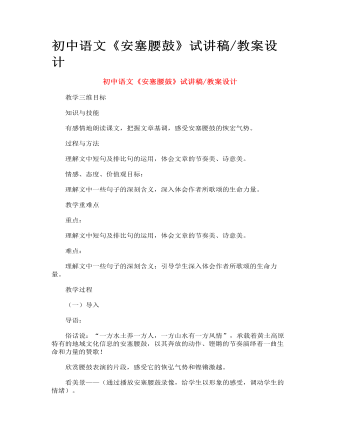
初中语文《安塞腰鼓》试讲稿_教案设计
精读课本,贯通全文 提问:整篇文章极富震撼力,文章中一个排比接一个排比,一个高潮连一个高潮,大家从中体味到了什么? 明确: A、这是一篇歌颂激荡的生命和磅礴的力量的文章。 B、全文洋溢着一种阳刚之美。 C、表现要冲破束缚、阻碍的强烈渴望。 朗读赏析探究 赏美图,配佳句——为了让大家对被誉为“天下第一鼓”的安塞腰鼓有更直观的认识,我们再来看几组特写照片。看后请各小组用课文中的文句与之相配并高声朗读。 明确:对排比句进行总结,说出对句子的理解。 怎样理解“耳畔是一声渺远的鸡声”? ①鸡啼预示天明,是新的一天的开始,是希望的象征。 ②这是以声衬静,用鸡啼反衬火烈的鼓声停止后大地的寂静。 说美点,品美韵——这篇文章美吗?美在哪里? 语言美: 课文多用短句来表现内容;大量运用排比,有句内、句与句、段与段之间的排比,交错出现,连用许多。
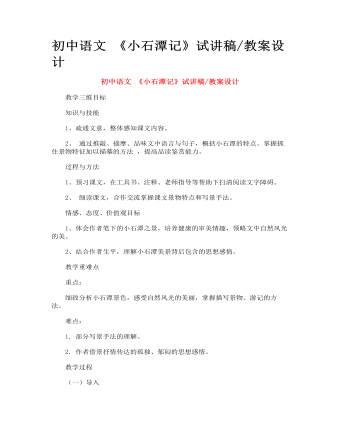
初中语文 《小石潭记》试讲稿_教案设计
大家都知道,在中国文学史上有不少的文人用他们的笔墨描写过优美的山水,比如说我们以前学过: 唐 杜牧《江南春》: 千里莺啼绿映红,水村山郭酒旗风。南朝四百八十寺,多少楼台烟雨中。 杜甫《望岳》:岱宗夫如何? 齐鲁青未了。造化钟神秀,阴阳割昏晓。 荡胸生层云, 决眦入归鸟。 会当凌绝顶, 一览众山小。 郦道元在《三峡》中也有“春冬之时,则素湍绿潭,回清倒影。”这样引人入胜的景色。可以说优美的山水诗文不可枚举,那么今天让我们跟随柳宗元一起走进小石潭,看看又是怎样的一幅山水画呢?他又是怎样的心情写下这篇游记的呢?
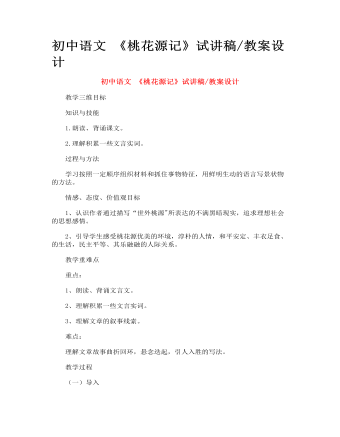
初中语文 《桃花源记》试讲稿_教案设计
陶渊明生于东晋末朝,出身于没落的地主官僚家庭。他少时颇有壮志,博学能文,任性不羁。当时社会动乱不安,他有志不得展。做过小官,由于不满官场的丑恶,弃官回乡,这时他四十一岁,从此过着“躬耕自资”的隐居生活。忧愤、饥寒、劳累、赢疾一起折磨着他,六十三岁去世。后称靖节先生。他所作的诗文,内容多描写农村生活,表现了优美的自然风光,抒发他热爱田园生活、乐于和农民来往和不愿与统治者同流合污的高尚感情;但也包含了乐天知命、消极适世的因素。在形式上一反当时华而不实的文风,明朗清新,质朴自然,善于抓住客观事物最突出的特征,淡淡几笔传神的表现它的形象,简洁含蓄而富有韵味,对后代作家有较大的影响。本文写作年代大约是宋永初二年(421年),其时陶渊明已经五十七岁了。他拒绝同刘格的来政权合作,不满黑暗的政治现实,同时由于他和农民接近,理解他们追求理想社会的愿望,所以写了这篇记和诗。

新人教版高中英语选修2Unit 2 Bridging Cultures-Discovering useful structures教学设计
The grammar of this unit is designed to review noun clauses. Sentences that use nouns in a sentence are called noun clauses. Nominal clauses can act as subject, object, predicate, appositive and other components in compound sentences. According to the above-mentioned different grammatical functions, nominal clauses are divided into subject clause, object clause, predicate clause and appositive clause. In this unit, we will review the three kinds of nominal clauses. Appositive clauses are not required to be mastered in the optional compulsory stage, so they are not involved.1. Guide the students to judge the compound sentences and determine the composition of the clauses in the sentence.2. Instruct students to try to learn grammar by generalizing grammar rules, controlling written practice, and semi-open oral output.3. Inspire the students to systematize the function and usage of noun clause1.Instruct students to try to learn grammar by generalizing grammar rules, controlling written practice, and semi-open oral output.2.Inspire the students to systematize the function and usage of noun clauseStep1: The teacher ask studetns to find out more nominal clauses from the reading passage and udnerline the nominal clauses.
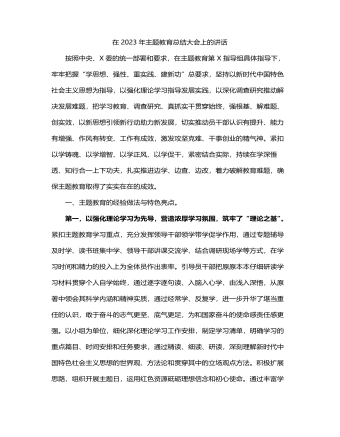
在2023年主题教育总结大会上的讲话
第三,进一步抓好问题整改落实,将主题教育问题整改与推进改革发展有机结合起来,严格对标对表,坚持统筹兼顾、标本兼治,确保整改落实全面到位,同时扎实做好第二批主题教育的谋划准备工作,确保整个主题教育上下联动、有机衔接。深刻认识检视整改是确保主题教育取得实效的关键一环,切实增强做好检视整改工作的政治自觉,坚持边学习、边对照、边检视、边整改,在抓好问题整改上下真功夫、下狠功夫,做到问题不解决不松手、整改不到位不罢休。对检视梳理的问题必须主动认领、自觉对号入座、深刻剖析根源,搞清楚是思想问题还是能力问题,是方法问题还是作风问题,是长期存在的顽瘴痼疾,还是最近才出现的急难杂症,做到真认账、真反思、真整改。从政治上认识、推进和检验整改工作,把人民群众满意不满意作为根本检验标准,增强“等不起、慢不得、坐不住”的紧迫感,把按时完成检视整改作为军令来执行,持续盯住问题不放、严格落实整改措施,确保事事有着落、件件有结果。把制度建设贯穿检视整改全过程,强化制度刚性约束,把整治成效转变为治堵效果,做到既谋当下、又管长远。

关于大学生三下乡支教教育个人心得体会八篇
我也是农村长大的孩子,在农村的日子就是我整个童年,虽然没有城市的繁荣和物质基础,但在农村我就是一只自由自在、欢乐无比的小鸟。走进白石小学,我仿佛又回到了我那个自由洒脱的童年。孩子们的欢声笑语,孩子们的调皮捣蛋,还有孩子们的聪明伶俐,无不让我感到开心和幸福。这种幸福感不像是亲人朋友给予的爱,而是把你带进你无法回到的过去的难忘时光。在我们安排的课程中,里面大多数是以第二课堂为主。为了吸引孩子们的注意和培养他们的兴趣,我们也是使出浑身解数,让课程变得有趣而不乏味。虽然经历了当老师的辛苦,但孩子们带给我们的欢乐和感动让我们觉得一切都值得。在我所参与的课堂中,我看到了“老师们”的窘迫,但孩子们却还是学得很认真笑得很开心。这就是我们现在无法相比的,孩子们的天真热情,单纯可爱,让我们这些最初不抱好想法的大学生感到温暖,很快,我们就融入其中了。
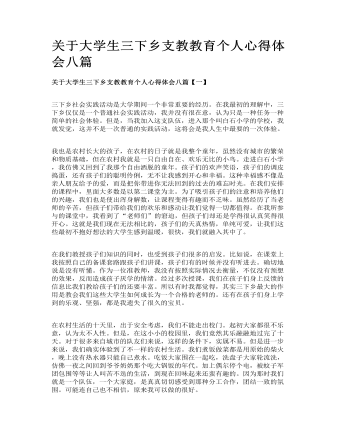
关于大学生三下乡支教教育个人心得体会八篇
在我们教授孩子们知识的同时,也受到孩子们很多的启发。比如说,在课堂上我按照自己的备课套路跟孩子们讲课,孩子们有的时候并没有听进去。确切地说是没有听懂。作为一位准教师,我没有按照实际情况去衡量,不仅没有预想的效果,反而造成孩子厌学的情绪。经过多次授课,我们在孩子们身上反馈的信息比我们教给孩子们的还要丰富。所以有时我都觉得,其实三下乡最大的作用是教会我们这些大学生如何成长为一个合格的老师的。还有在孩子们身上学到的乐观、坚强,都是我遗失了很久的宝贝。
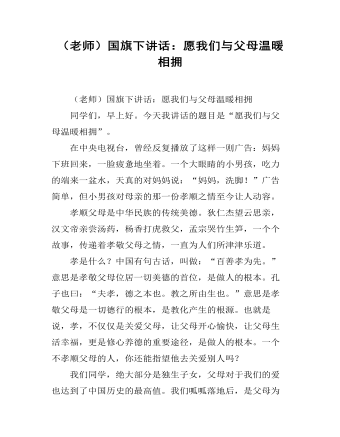
(老师)国旗下讲话:愿我们与父母温暖相拥
在中央电视台,曾经反复播放了这样一则广告:妈妈下班回来,一脸疲惫地坐着。一个大眼睛的小男孩,吃力的端来一盆水,天真的对妈妈说:“妈妈,洗脚!”广告简单,但小男孩对母亲的那一份孝顺之情至今让人动容。孝顺父母是中华民族的传统美德。狄仁杰望云思亲,汉文帝亲尝汤药,杨香打虎救父,孟宗哭竹生笋,一个个故事,传递着孝敬父母之情,一直为人们所津津乐道。孝是什么?中国有句古话,叫做:“百善孝为先。”意思是孝敬父母位居一切美德的首位,是做人的根本。孔子也曰:“夫孝,德之本也。教之所由生也。”意思是孝敬父母是一切德行的根本,是教化产生的根源。也就是说,孝,不仅仅是关爱父母,让父母开心愉快,让父母生活幸福,更是修心养德的重要途径,是做人的根本。一个不孝顺父母的人,你还能指望他去关爱别人吗?

主题教育总结常用提纲大全
第一,主题教育是一次思想作风的深刻洗礼,初心传统进一步得到回归。第二,主题教育是一次沉疴积弊的集中清扫,突出问题进一步得到整治。第三,主题教育是一次强化为民服务的生动实践,赤子之情进一步得到提振。第四,主题教育是一次激发创业担当的有利契机,发展层次进一步得到提升。2.第一,必须提领思想、武装思想。第二,必须聚焦问题、由表及里。第三,必须领导带头、以上率下。第四,必须务实求实、认真较真。3.一是抬高政治站位,坚持大事大抓。二是坚持思想领先,狠抓学习教育。三是突出问题导向,深入整改纠治。四是坚持领导带头,发挥表率作用。4.一是立足“早”字抓筹划。二是着眼“活”字抓学习。三是围绕“统”字抓协调。5.一是形势所需。二是任务所系。三是职责所在。四是制度所定。6.一要提升认识。二要积极作为。三要密切协作。
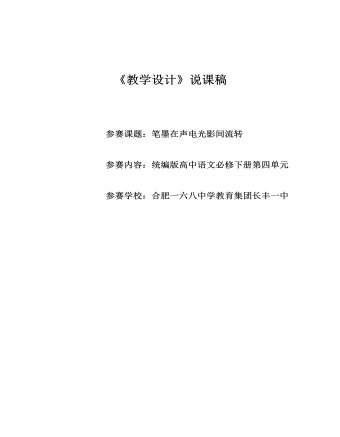
第四单元《教学设计》 说课稿 2021—2022学年统编版高中语文必修下册
(六)说教学策略1.专题性海量的媒介信息必须加以选择或者整合,以项目为依据,进行信息筛选,形成专题性阅读与交流;培养学生对文本信息“化零为整”的能力,提升跨媒介阅读与交流学习的充实感。2.情境化情境教学应指向学生的应用,建构富有符合时代气息的内容,与生活经验更加贴合,对学生的语言建构与运用有所提升,在情境中能够有效地进行交流。3.任务化以任务为导向的序列化学习,可以为学生构建学习路线图、学习框架等具体任务引导;或以跨媒介的认识与应用为任务的设置引导;甚至以阅读和交流作为序列化安排的实践引导。4.整合性跨媒介阅读与交流是结合线上线下的资源,形成新的“超媒介”,也能实现对信息进行“深加工”,多种媒介的信息整合只为一个核心教学内容服务。5.互文性语言文字是语文之生命,我们是立足于语言文字的探讨,音乐、图像、视频等文本与传统语言文字文本形成互文,触发学生对学习内容立体化和具体化的感悟,提升学生的审美能力。
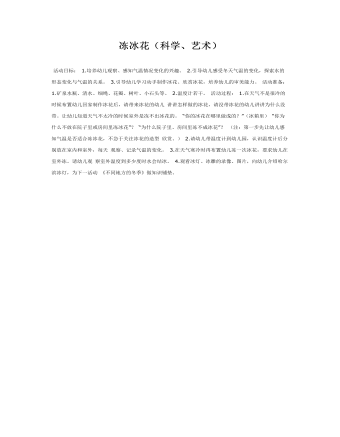
大班科学教案:冻冰花(科学、艺术)
2.引导幼儿感受冬天气温的变化,探索水的形态变化与气温的关系。 3.引导幼儿学习动手制作冰花、欣赏冰花,培养幼儿的审美能力。活动准备: 1.矿泉水瓶、清水、细绳、花瓣、树叶、小石头等。 2.温度计若干。活动过程: 1.在天气不是很冷的时候布置幼儿回家制作冰花后,请带来冰花的幼儿讲讲怎样做的冰花,请没带冰花的幼儿讲讲为什么没带。让幼儿知道天气不太冷的时候室外是冻不出冰花的。 “你的冰花在哪里做成的?”(冰箱里) “你为什么不放在院子里或房间里冻冰花”? “为什么院子里、房间里冻不成冰花”?



